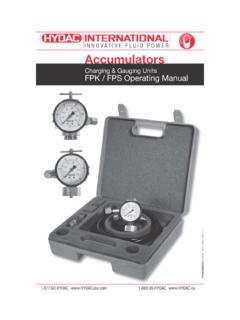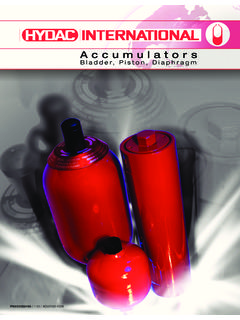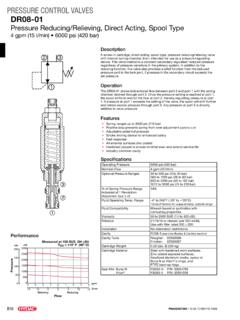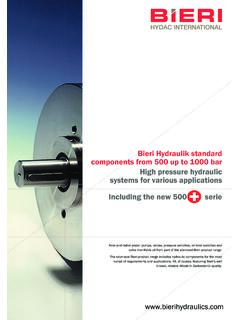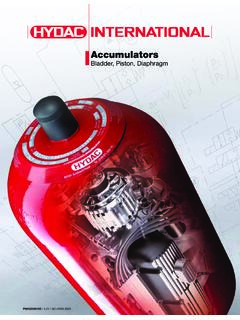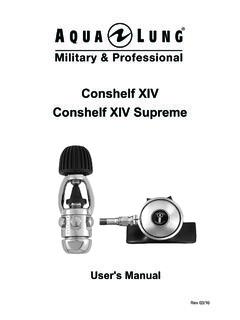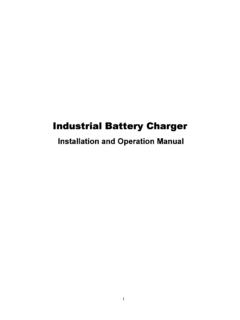Transcription of ACU1501-1664%20SB210-600 MainBroch PN2073469
1 INNOVATIVE FLUID POWER1PN#2073469 / / ACU1501-1664SB 210 to 600 Bladder Accumulators Maintenance & Service InstructionsIndex1. GeneralBottom Repairable Bladder Accumulators2. Spare Parts Torque Requirements3. Maintenance Inspection Of AssemblyTop Repairable Bladder Accumulators4 Spare Parts Torque Requirements5 Maintenance Inspection Of AssemblyWARNING !Hydraulic accumulators are pressurized vessels and only qualified technicians should perform repairs. Never weld, braze or perform any type of mechanical work on the accumulator shell. Always drain the fluid completely from the accumulator before performing any work, such as recommended repairs or connecting pressure Tools Required:1.
2 HYDAC Charging and Gauging Unit: For bottom repairable bladder accumulators: FPS or FPK with adapter FPK/SB may be used. For top repairable bladder accumulators only the FPK with adapter FPK/SB may be Gas Valve Core Tool3. Spanner Wrench(es)4. Bladder Pull Rod5. Sockets 27mm / 32mm (top repairable only) / 36 mm6. Blunt Flathead Screwdriver (with rounded edges)NOTE: Additional standard tools are required including but not limited to: Soft Faced Hammer / Sockets / Torque Wrenches /anti seize compound for stainless steel to additional information contained in the Operating and Installation Instructions for HYDAC Accumulators .The instructions included in this brochure cover Bottom Repairable and Top Repairable Bladder servicing a bladder accumulator obtain the appropriate HYDAC repair kit.
3 Use only original HYDAC replacement all instructions thoroughly before beginning any type of service or repair : All details subject to technical modificationTo safeguard against a potential source of danger which can occur in bladder and diaphragm accumulators, we would like to draw your attention to the following note that this should be taken into account when carrying out any work on systems with hydraulic VESSEL USE DRY NITROGEN GAS ONLYP lease refer to HYDAC Operating and Installation InstructionsCAUTION!After discharging and/or completely draining the accumulator ( to depressurize the hydraulic system before work is carried out), the accumulator can build-up an amount of pressure again when the lines are later shut off on the fluid problem must be taken into account generally and in particular before carrying out work on hydraulic systems which include connected hydraulic the fluid-side lines connected to the accumulator must therefore be depressurized and after that the lines remain open.
4 Only then may the appropriate work ( disassembly of the accumulator) be carried !INNOVATIVE FLUID POWER2PN#2073469 / / ACU1501-1664 Maintenance15162317151617 Detail X SB 210SB 330: size 1 to 54SB 600: size 1 to 4SB 330N: size 1 to 54 SB330/400 (european mfg) to 6L6 Detail Z8341214 Detail X189171920735 Detail Z ( ) Torque Requirements: Bottom Repairable Bladder Accumulators in Nm (lb-ft)Part NameSB 210/ SB 330 / SB330 NSB 330 H / SB 400 / SB500SB 550SB 600 / SB 600N14 to 610 to 5410 to 201 to 51 to 410 to 54 Gas Valve ( ) ( ) ( ) ( ) ( ) ( ) ( )Bladder Stem Lock Nut80 (59)80 (59)80 (59)80 (59)80 (59)80 (59)150 (111)Valve Seal Cap30 (22)30 (22)30 (22)30 (22)30 (22)30 (22)30 (22)Fluid Port Lock Nut90 (66)200 (148)440 (325)600 (443)150(110)200 (148)440 (325)Vent Screw1)4 (3)22 (16)30 (22)30 (22)4 (3)22 (16)30 (22)1) For SAE threads only.
5 For other thread types, consult Replacement Parts Drawing: SB210, SB330, SB330H, SB330N, SB400, SB500, SB550 SB600, SB600 NItem Description:1 Shell2 *Bladder3 Gas Valve Core4 *Bladder Stem Lock Nut5 *Valve Seal Cap6 Valve Protection Cap7 *O-ring8 Name Plate9 Fluid Port14 Anti-extrusion Ring15 Flat Ring16 O-ring17 Spacer Ring18 *Fluid Port Lock Nut19 Fluid Port Vent Screw20 Seal Ring23 Back-up RingRepair Kit Consists Of:2 Bladder3 Gas Valve Core4 Bladder Stem Lock Nut (SB 600 only)5 Valve Seal Cap7 O-Ring15 Flat Ring16 O-Ring23 Back-up Ring (where applicable)*Complete model code required.
6 Must state A1 or S11 All SB 50L assemblies use the M50(2 ) diameter gas valve, not the M22 (7/8 ) diameter gas 600: size 10 to 54SB 600N: size 10 to 54 SB330/400/500/550 (european mfg)10 to 50 LINNOVATIVE FLUID POWER3PN#2073469 / / ACU1501-1664 MaintenanceFEDCB3. Bottom Repairable Bladder DisassemblyA After removal from the system, place the accumulator in a vice or secure it to a workbench. Remove valve protection cap (item 6) and unscrew valve seal cap (item 5). Attach the proper HYDAC Charging and Gauging Unit and completely relieve the gas precharge (refer to HYDAC Charging and Gauging brochure #02068202). Remove gas valve core (item 3) by using the gas valve core tool.
7 B Unscrew vent screw (item 19) and remove seal ring (item 20). Unscrew lock nut (item 18) by using spanner wrench. Remove spacer ring (item 17). If necessary, tap spacer ring with a plastic hammer to Loosen fluid port (item 9) and push it into the shell. Remove back-up ring, (item 23) where applicable, O-ring (item 16) and flat ring (item 15) from fluid Pull anti-extrusion ring (item 14) off fluid port and remove it through fluid side opening by folding it in Remove fluid port (item 9).F Remove bladder stem lock nut (item 4) and name plate (item 8) from the gas side. Remove bladder (item 2) from fluid side. It may be necessary to fold the bladder lengthwise to remove Inspection of ComponentsShell: inside to ensure it is free of debris, rough spots, or chafe marks.
8 Fluid side bore for damage which could hamper proper sealing. exterior for any sign of any interior or exterior damage is found, contact HYDAC for proper repair or replacement : The bladder must be checked for leakage. Reinstall gas valve core (item 3) and charge the bladder with nitrogen or compressed air to its natural shape and inspect for leakage occurs, first check the gas valve core (item 3) and replace it if necessary. If leakage still occurs, then the bladder must be replaced. The bladder must be visually inspected for lateral grooves and deep chafe marks. If any are found, the bladder should be replaced. Shallow chafe marks are insignificant and will not hamper : Bladders can not be repaired or revulcanized!
9 Fluid Port: Depress poppet and rotate 90 to ensure free movement. Visually inspect poppet, threads, and sealing surfaces for any damage. If any damage is found, the fluid port should be Anti-extrusion Ring: Visually check vulcanized area between steel and rubber to make sure it is undamaged and that adhesion is still good (no gaps between rubber and metal). If the adhesion is poor or the rubber is cracked or shows signs of embrittlement or aging, replace anti-extrusion ring. Also check the seat area on the steel parts for grooves or any other damage. If any are found replace anti-extrusion Anti-extrusion Ring: Visually inspect area between the steel and rubber to make sure that the steel ring is properly seated.
10 If the rubber is cracked or shows signs of embrittlement or aging, replace anti-extrusion ring. Also check the seat area on the steel parts for grooves or any other damage. If any are found replace anti-extrusion : New seals should always be used whenever reassembling any bladder Parts: Inspect for damage and replace if FLUID Assembly:The interior of the shell must be absolutely free of any contamination or debris prior to bladder for installation by removing valve seal cap (item 5), and gas valve core (item 3). Press all residual air out of Lubricate interior of shell and exterior of bladder with appropriate filtered fluid, using a fluid volume of approximately 10% of total accumulator volume.
